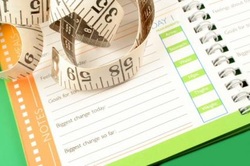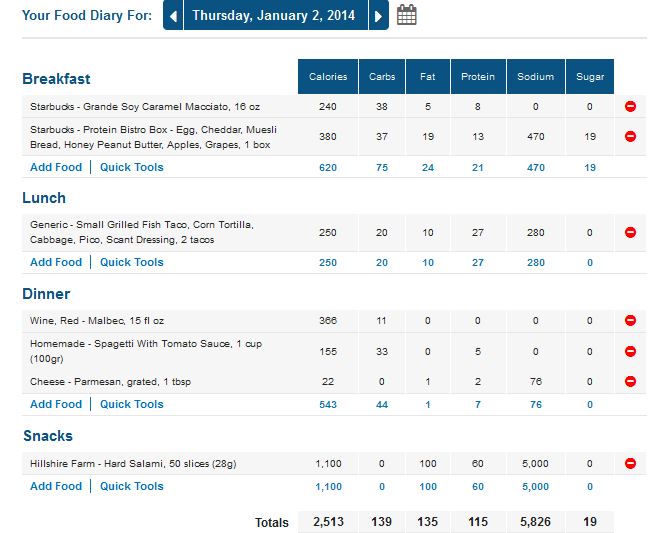 There will be no ‘before’ and ‘after’ pictures in this blog, mostly because I am not the type to flash my belly in a swim suit (regardless of how flat it may be). This blog is all about science of nutrition. Step 1: Food Diary There are a lot of different ways to keep a food log. In the old days I would simply record everything I consumed in a day and used a nutrition reference guide to break things down by carbohydrates, fat and protein. That was a lot of work! Now we can use all sorts of web and mobile apps. One of my favorites is MyFitnessPal – it is free, available online and on your phone and even has a barcode scanner. This app is similar to Weight Watchers, but you can actually see calories. (And did I mention free? As in not paying a corporation?) Do not forget to write down all the food you eat including condiments, sugar, and beverages for three non-consecutive days in a week – two week days and one weekend, then average the number of calories. Step 2: Body Mass Index Clinicians use the Body Mass Index (BMI) to assess a patient’s risk for developing obesity associated diseases. A normal weight BMI is 18.5 – 24.9; overweight is 25 – 29.9 and obese is 30 and greater. If my current weight is 150 lbs and my height is 5’2” (at least I like it to be that) my BMI can be calculated as: BMI = = x 703 = x 703 = 27.4 This puts me in the overweight category – I am not happy. Step 3: Resting Metabolic Rate Resting Metabolic Rate is the amount of energy (in calories) a person burns daily. We need this energy for keeping our vital organs alive and digesting the food we eat. In other words, if you lay in bed all day and do absolutely nothing RMR is how many calories you will burn. Here is an example of how RMR can be calculated: Weight – 150 lbs; Height – 5’2” or 62”; Age – 45; Gender - female Men: (9.99 x Weight (kg)) + (6.25 x Height (cm)) – (4.92 x Age (years)) +5 Women: (9.99 x Weight (kg)) + (6.25 x Height (cm)) – (4.92 x Age (years)) -161 = (9.99 x 68.2) + (6.25 x 157.5) – (4.92 x 45) – 161 = 681.3 + 984.4 – 221.4 – 161 = 1283.3 Kcal Step 4: Activity Level There are many different ways to determine daily activity level. This table is one of them; it helps you to find your activity factor to calculate the actual calories you burn every day, just be honest! I like to think I walk at least 7 miles every day which includes my morning routine of either walking or slow jogging for 45 minutes (approximately 3 miles), walking 30 minutes at lunch time (1.2 miles) and all other walking throughout the day: that can include office, grocery store, et cetera. The best way to confirm this is by purchasing a small pedometer and wearing it for a day. This will help estimate daily activity level with more precision.
My daily energy requirement can be calculated as follows: RMR x 1.6 = 1283.3 x 1.6 = 2053.28 Kcal Of course, when I average my food intake from my own food logs I notice that I consume at least 500 Kcal more than I should. No wonder I’m gaining weight! My smart book suggests subtracting 500 to 1000 Kcal from my energy requirement which will assure weight loss of 1 to 2 pounds per week. Well, let’s not go crazy, let’s be realistic. Losing one pound a week is great and brings me to get to my goal of 125 lbs in a little over half a year (4 lbs per month). Wow! But is it realistic? Not in my situation. What if I don’t have time to walk during the day? What if I drink an extra glass of wine? I don’t want to be disappointed. More to the point, I don’t want to be too restrictive in my diet and enjoy food. Losing a pound every two weeks is what I will be able to accomplish. This means subtracting 250 kcal from my daily energy requirements leaving me with approximately 1800 kcal per day. This is doable! Let’s begin.
0 Comments
 No one likes to make New Year resolutions – not because the promise you give to yourself isn’t serious, but mostly because you can’t keep it: two weeks tops! It would be much safer not to make any resolutions at all; at least this is how I feel. Well, on this note I decided to make another New Year resolution. My logic includes the following: I am quite an accomplished individual, I finish what I start and with the best results possible. There are only two things in my life that I am always failing at – quitting smoking and losing weight. I lost weight once, in year 2000, dropped approximately 25 pounds, but over the past 13 years I got it all back and more. Quitting smoking was never successful. I tried every year, a few times a year over the last 17 years and failed every time. Year 2012 was the worst – I lost a job that I really liked followed by a serious back injury leaving me immobile for a few months. I could not run, could not walk, I could not even sit; lying down on the floor was my only option. Unfortunately, my appetite was not affected by the injury, so I gained a few more pounds. This year was good to me and I feel accomplished and successful, after all 13 is my lucky number! I graduated with my second Master’s degree, got an amazing job offer, fully recovered from the back injury and guess what? I QUIT SMOKING FOR GOOD! Yes, it’s been 6 months and I have not had a single cigarette! Now it’s time for the second task – lose weight. Generally speaking, I try to stay active and healthy as much as possible. I walk, ride my bike sometimes, and even started jogging again. I don’t eat junk food (chips, soda, etc.), and try to have a nutritionally balanced diet. But something is still missing. Slowly but surely my sizes go up and I start avoiding scales in the bathroom. One day I was reading the Health Magazine (not the best publication, but it happened to be in my hands at the time), and suddenly experienced a ‘light bulb’ effect. Eureka! I realized what was missing in my life – structure! So, as a nutritionist with training in counseling and dietetics I decided I should start with an assessment which includes a diet log (three non-consecutive days per week), calculations of BMI (Body Mass Index), and BMR (Basic Metabolic Rate). For nutrition nerds and just curious folks I’ll be posting formulas, calculations and examples of a diet log in my next post. Stay tuned! |
AUTHOR
Mariya Power has a Master's Degree in Nutrition and Food Science from the University of Vermont; has conducted research on effects of cinnamon extract in type II diabetes, and is a passionate yoga enthusiast. Archives
March 2015
Categories
All
|
Web Hosting by IPOWER


 RSS Feed
RSS Feed